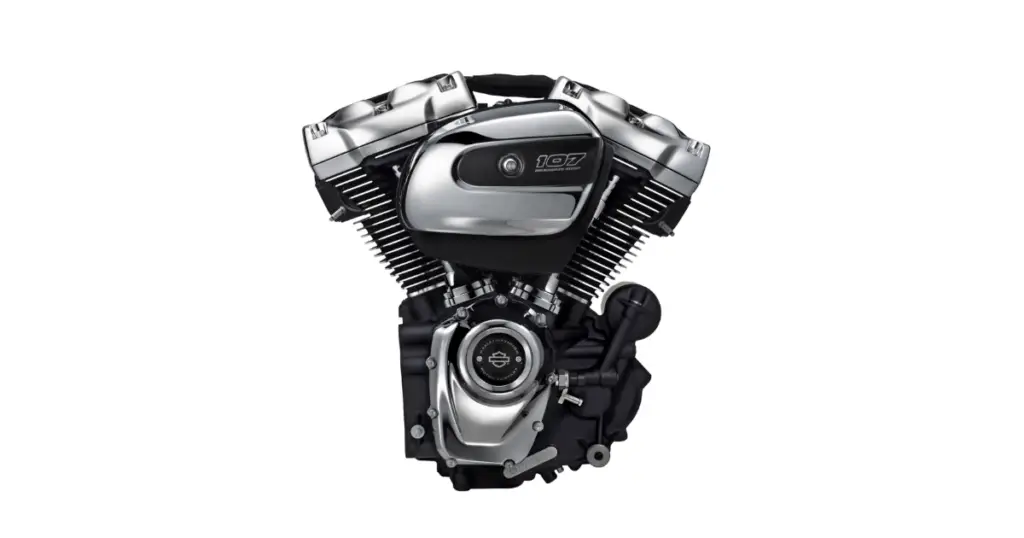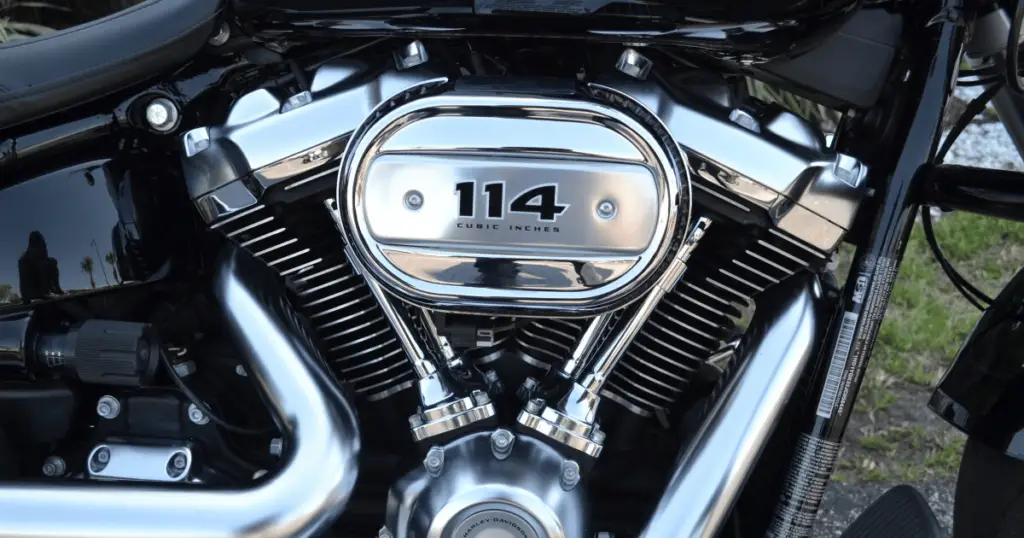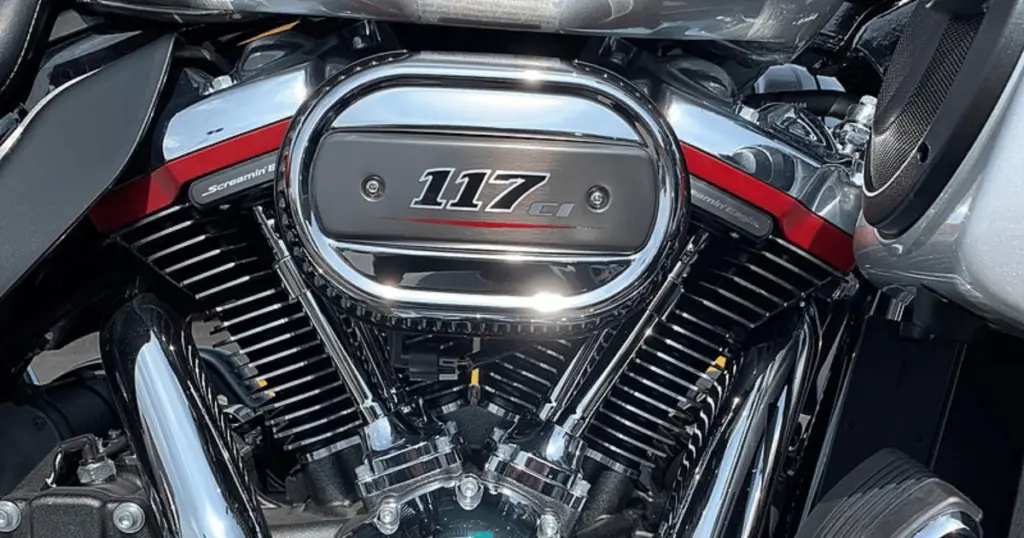When it comes to the battle of supremacy between Harley’s M8 series engines, narrowing down your choice to the perfect fit can feel like a trip on uncharted roads. And the debate on “Harley 107 vs 114 vs 117” is nothing short of a heavyweight championship bout that has motorcycle enthusiasts at the edge of their seats.
In this article, we’ll zoom into the m8 107 specs, the m8 114 specs, and finally, the m8 117 specs, to help you understand what really sets each engine apart, and most importantly, which might be the best fit for your Harley riding experience. As your go-to motorcycle mentor, we’ll hitch a ride together, navigating those winding roads, and decode the big riddle using simple, jargon-free language. We’ll also pepper the conversation with seasoned motorcycle anecdotal wisdom and hands-on experiences. So, buckle up and get ready for a thrilling ride into the heart of Harley’s M8 engine series!
Harley 107 Overview

Specifications
The Milwaukee-Eight 107 engine features a displacement of 107 cubic inches (1746 cc) and provides a horsepower of around 92.5. It has a torque of 111.4 ft-lb at 3250 rpm and a compression ratio of 10.0:1.
Release Date
The Milwaukee-Eight 107 was first introduced in Harley-Davidson’s 2017 model lineup. It was a significant upgrade over the previous Twin Cam engines.
Equipped Models
Harley-Davidson equipped the 107 engine in several models, including the Street Glide, Road King, and Electra Glide.
Read more:
> Street Glide vs Road Glide: Who Glides The Best?
> Electra Glide vs Street Glide: Any Real Difference?
> Road King vs Street Glide: Who Glides The Best?
Harley 114 Overview

Specifications
The Milwaukee-Eight 114 engine boasts a displacement of 114 cubic inches (1870 cc) and produces around 100.5 horsepower. It delivers a torque of 124 ft-lb at 3250 rpm and has a compression ratio of 10.5:1.
Release Date
The 114 engine was launched alongside the 107 engine in the 2017 Harley lineup, but only for the high-end models.
Equipped Models
Harley-Davidson featured the 114 engine in their special edition models such as the Road Glide Special and Street Glide Special.
Harley 117 Overview

Specifications
The Milwaukee-Eight 117 is the largest factory-installed engine from Harley-Davidson, with a displacement of 117 cubic inches (1923 cc). It offers the highest power among the three, with a torque of 126 ft-lb at 3750 rpm and a compression ratio of 10.2:1.
Release Date
The 117 engine debuted in Harley’s 2018 CVO (Custom Vehicle Operations) models.
Equipped Models
The 117 engine is exclusive to Harley-Davidson’s CVO models, including the CVO Road Glide and CVO Street Glide.
Related: The Worst Harley 117 Problems Get Fixed
Related reads:
– Harley M8 Oil Capacity Guide (All Sizes Explained)
– Harley M8 Primary Oil Capacity (All Engine Sizes Explained)
– The Best Oil for M8 Harley Engines Gets Revealed (Complete)
Comparative Analysis and Reliability
When it comes to choosing between the Harley 107, 114, and 117 engines, it’s crucial to consider their performance and reliability side-by-side. The 107 offers a balanced ride with steady performance, making it a reliable choice for daily commuting. The 114, on the other hand, strikes a sweet spot between performance and reliability, suitable for those who crave a bit more power in their ride. The 117 is the powerhouse of the trio, delivering top-notch performance that is perfect for riders seeking adrenaline-pumping rides.
All three engines are known for their durability, but like any mechanical device, they have their quirks. The 107 and 114 engines have been noted for their heat management issues, while the 117, with its higher performance, may require more frequent check-ups to ensure everything is running smoothly.
Performance Upgrades and Customization
For those looking to enhance the performance of their 107 or 114 engines, a Stage 2 upgrade is a popular choice. This upgrade can significantly boost the horsepower and torque, bringing the 107’s performance closer to that of the 114. Customization options are plentiful for all three engines, with a myriad of aftermarket parts available to enhance performance, reliability, and aesthetics.
Riding Experience and Style
Choosing the right engine also depends on your preferred riding style. The 107 is well-suited for city commuting and everyday riding, offering a smooth and steady performance. The 114 is versatile, providing a balanced ride for both city commuting and longer journeys. For those who live for long-distance touring and crave raw power, the 117 is the engine of choice.
Maintenance and Care
Maintaining your Harley is key to ensuring its longevity and performance. Regular oil changes, air filter replacements, and checking the tension of the primary chain and belts are essential for all three engines. Additionally, be mindful of any common maintenance issues specific to each engine and address them promptly to avoid any long-term damage.
Cost Considerations
In terms of cost, the 107 is the most budget-friendly option, while the 117 is at the higher end of the spectrum. The 114 offers a middle ground, providing a balance of performance and cost. Consider your budget not just for the initial purchase, but also for potential upgrades and maintenance down the line.
User Reviews and Testimonials
Many riders have shared their experiences with these engines. “The 107 has been nothing but reliable for my daily commutes,” shares one Harley enthusiast. Another rider, who upgraded from a 107 to a 114, mentions, “The difference in power is noticeable, and it’s worth every penny.” CVO owners rave about the 117’s performance, with one rider stating, “It’s like riding a rocket, the power is incredible.”
Check this out: The Best Tuner For Milwaukee 8 114 Engines (+Alternatives)
Is One Engine Better Than The Other?
Technically speaking, each engine has its strengths. The 117 delivers the highest performance numbers. However, the best engine for you would depend on your individual preferences and riding style.
How Do You Decide Which Engine Is Right For You?
Choosing the right engine depends on several factors such as your riding habits, power requirements, budget, and preference for smooth power delivery or raw acceleration.
What’s The Most Reliable Milwaukee 8 Engine?
All three engines—107, 114, and 117—are recognized for their reliability. However, like any mechanical device, they are prone to certain issues.
107ci Engine Specific Problems
Despite its steady performance, the 107 engine has been reported to have issues:
- Heat Management Issues: Some riders have reported that the 107ci engine tends to run hot, especially during long rides or in warmer climates.
- Oil Pump Failures: There have been instances of oil pump failures, leading to inadequate lubrication and potential engine damage.
- Transmission Issues: Some riders have experienced issues with the transmission, including hard shifting and noise.
- Compensator Failures: The compensator, which smoothens out the engine’s power pulses, has been known to fail, leading to a rougher ride.
- Camshaft Wear: Premature wear of the camshaft can occur, affecting the engine’s performance.
- Clutch Problems: Some riders have reported issues with the clutch, including slippage and difficulty in engagement.
Read more: Harley 107 vs 114: Milwaukee 8 Worth The Hype? Yes and No
114ci Engine Specific Problems
Similar to the 107, the 114 engine also faces several issues:
- Overheating: Like the 107ci, the 114ci engine can also suffer from overheating, particularly in stop-and-go traffic or during extended rides.
- Oil Pump Issues: There have been reports of oil pump issues, leading to inadequate oil pressure and potential engine damage.
- Transmission Problems: Some riders have faced transmission issues, including hard shifting and noise.
- Starter Problems: Issues with the starter motor have been reported, leading to difficulties in starting the bike.
- Sensor Failures: Failures in various sensors, such as the oxygen sensor, can lead to poor performance and reduced fuel efficiency.
- Vibration: Some riders have noted excessive vibration at certain RPMs.
Related: Is The Harley 114 A Good Engine? Yes and No (Here’s Why)
117ci Engine Specific Problems
The 117 engine, being the most powerful, also has its share of problems:
- Heat Management: The 117ci engine, being the most powerful, can generate a significant amount of heat, leading to overheating issues.
- Oil Pump Failures: Like the other engines, the 117ci is not immune to oil pump failures, which can lead to serious engine damage if not addressed promptly.
- Transmission Issues: Riders have reported issues with the transmission, including hard shifting and noise.
- Camshaft Wear: Premature wear of the camshaft can occur, affecting the engine’s performance and longevity.
- Clutch Problems: Issues with the clutch, including slippage and difficulty in engagement, have been reported.
- Sensor Failures: Failures in various sensors can lead to poor performance and reduced fuel efficiency.
Related: Milwaukee 8 Problems: Too Much To Handle? Yes and No
Are There Any Open Recalls For These Engines?
Harley-Davidson regularly issues recalls for its motorcycles, including those equipped with the 107, 114, and 117 engines. It’s always important to check if your bike is subject to any recalls.
Related: Milwaukee 8 Oil Pump Recall: Should You Worry? Let’s See!
Which Engine Would I Pick?
This largely depends on personal preference and riding style. If you’re looking for smooth power delivery and superior performance, the 117 could be the best choice. However, if cost-effectiveness and steady performance are more important to you, then the 107 might be a better fit.
Related: Twin Cam vs Milwaukee 8
I Prefer The Performance of The 117
The 117 engine offers the highest performance among the three. Its larger displacement and higher torque make it a favorite among many riders.
But, The 114 Is More Readily Available
While the 117 offers superior performance, the 114 engine is more readily available and equipped in a broader range of Harley-Davidson models.
Ending Thoughts
In the end, whether you choose the Harley 107, 114, or 117 engine will depend on your personal preferences, riding style, and budget. Each engine has its unique advantages, and no matter which one you pick, you’ll be guaranteed a thrilling ride on the open road.